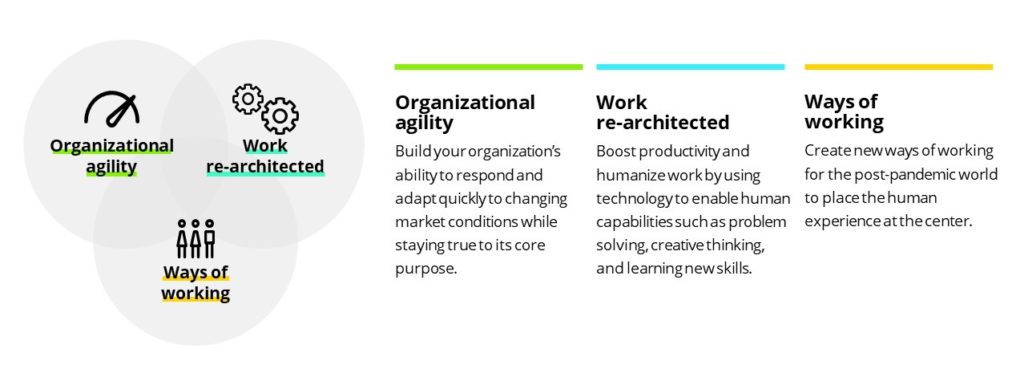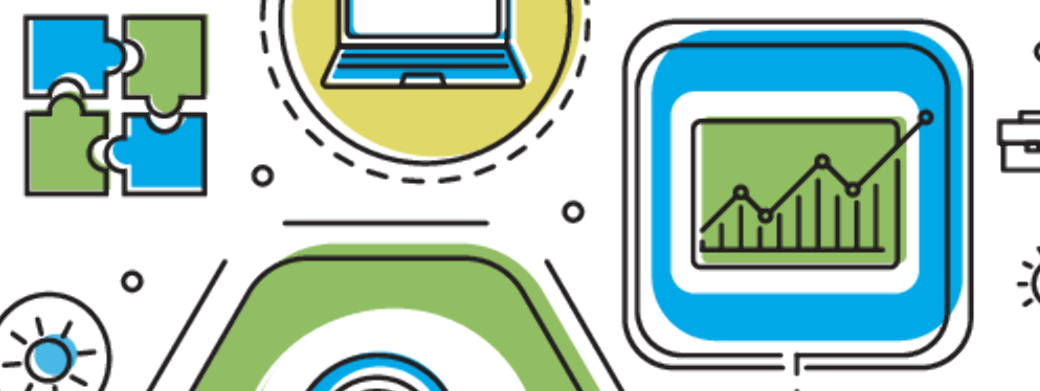COVID-19 hugely disrupted the workforce experience, straining the worker-employer relationship. Companies continue to face critical challenges as employees rethink where, how, and why they want to work. Talent mobility is high today, and the Great Resignation has employers re-examining how they can retain workers. While financial incentives are still important to American workers, flexible work arrangements, meaningful work, and better work-life balance are also high on the list. To meet these needs, organizations can intentionally “humanize” work in ways that meaningfully engage workers to attract and retain top talent.
In this three-part series, we’ll explore how companies can intentionally build resilience by designing an agile organization, re-architecting the work itself, and reimagining ways of working to prioritize the workforce.

In part 1, we discussed ways companies can increase their organizational agility. Here in part 2, we look at how we can humanize the work being done to increase productivity and engage workers.
What it means to “re-architect” work
Historically, we’ve been adding technology to the workplace but haven’t paused to look at the work itself. If done right, work can be the source of increased productivity, purpose, and bottom-line results. Re-architecting work is about deliberately designing work in ways that allow human capabilities (e.g. solving problems, building relationships, learning new skills) to flourish and focus their collective energies on desired outcomes rather than output. By determining the right interplay of human and technological capabilities, organizations can achieve not just cost reductions (optimizing efficiency), but also value (increasing benefits for stakeholders), and meaning (support others in making a difference). Lastly, re-architecting work is not a one-time fix. Instead, companies must constantly sense and re-evaluate the work at hand in the face of disruptions.
How to re-architect work
Today, 61% of executives are shifting their focus from optimizing work to reimagining work, as opposed to 29% before the pandemic. The following four actions may be helpful in ramping up re-architecting endeavors:
- Identify outcomes to humanize work for greater productivity. Instead of focusing on specific tasks and deliverables (e.g., creating a sales dashboard), shift the focus to outcomes (e.g., identifying unseen sales trends).
- Create new workflows to enable each work outcome. Involving those who perform the work, build a workflow with a fluid set of interactions enabled by technology.
- Identify the existing or needed technologies to power those workflows. Examine the workflow and determine which technological capabilities already exist in your organization, which ones you need to develop, and how you can architect them into an integrated flow.
- “Re-architect” those technologies and deploy them throughout the organization. Prioritize value flows to pursue. Build a minimum viable product to deploy quickly to the organization and encourage continuous improvements.
Re-architecting work in action: A case study
A health care system was facing critical staffing shortages and widespread burnout issues among its nurse practitioners, which only became more amplified in 2020. Nurse practitioners, dealing firsthand with the effects of the pandemic, were also burdened by a complex patchwork landscape of technologies. They were forced to spend significant time sifting between paper documents, knowledge management and ERP systems, and emails, which hindered their ability to focus on their patients.
Seeing this disconnect between the time nurse practitioners spent on administrative activities and their time with patients, the organization set about reimagining what workers should focus their time on, and what technology needs were there to support each task. As a result, the health care system is on its way to reducing administrative work for its nurse practitioners, allowing them to focus on delivering excellent patient care and improving their work-life balance. The changes will also improve the quality of scheduling and staffing solutions while also reducing costs and time. The integrated system of capabilities will help enable better workflows that benefits both the organization and its patients as well as the overworked nurse practitioners.
While the pandemic challenged workforces around the world, it also presented opportunities to enact long-term changes, which can enable companies to be more resilient against future events and engage their workforce. By finding the right interaction of human and technological capabilities, organizations can re-architect the work itself to unlock meaning, productivity, and the full potential of its workforce. In our next blog post, we’ll wrap up our series on building resilience by co-creating your organization with your workforce.
Endnotes
- Corporate Leadership Council Employee Engagement Survey.
- “Building Business Value with Employee Experience,” MIT CISR Research Briefing 17, no. 6 (2017).
AlignOrg Solutions: AlignOrg Solutions is a consulting firm that specializes in helping clients clarify strategy, design and align organization systems and choices, and lead transformational change to drive growth and marketplace success. Learn more about AlignOrg Solutions and our work and thinking here.
Deloitte: Deloitte’s Human Capital professionals help clients reimagine the work, workforce, and workplace of the future – we make work better for humans, and humans better at work. We work with executives to translate their business strategy into optimal structures with clear roles and responsibilities. Learn more about our Organization Design solutions here.
Authors: Reed Deshler, Don Miller, Diane Sinti, Maya Bodan, Nathan Mesaros, Yuki Iwase, Zach Mellen
